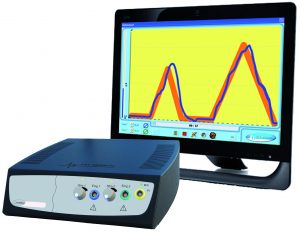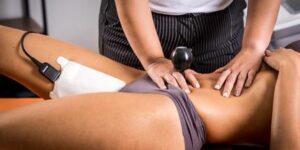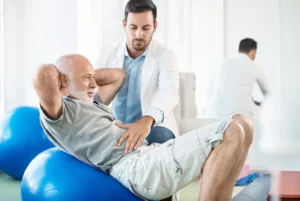Biofeedback in perineal rehabilitation
French moms (or the one who did their pelvic floor rehabilitation in france) will tell you part of the treatment was about to play a video game by contracting their pelvic floor muscles! They are speaking about BiofeedBack.Before to speak about this pelvic floor video game, let’s put it in context by summarising how perineal rehabilitation work!
Little reminder! As I already mentioned in previous articles, your perineum is part of whole and is similar to a hammock as it is supporting the weight of your bladder, uterus and rectum. Gravity (not your friend) is pulling on these 3 organs as soon as you stand up. So all day long your pelvic floor muscles work to keep everything in place. It is why, urine leakage only happen when you are standing up, running, jumping, laughing, coughing… Basically when something is pulling on your pelvic floor muscles! Even though pelvic floor rehabilitation starts lying on your back, at some point you will need to learn how to control your perineum muscles when you are standing up, walking, jumping… When you live your normal life!
This is essential as some women have a very strong pelvic floor muscles and able to produce powerful contraction as they are lying on their back.
But completely unable to have a correct pelvic floor function when they jump, laugh or walk quickly!
Having strong muscles is one thing, being able to use them correctly is another one!
Therefore, a pelvic floor rehabilitation (doesn’t matter if it is for a prolapses or incontinence) always start with a full body check-up. As I am repeating all the time, your perineum is part of a whole and its examination must not be limited to vaginal examination.
It is essential to start with a postural/balance check-up, followed by an evaluation of your abdomen and pelvis joint, to only then finish with a perineal examination.
Any dysfunction of the above elements may be a predisposing factor to perineal weakness and related incontinence or prolapse.
The vaginal examination gives the opportunity to determine the grade of a prolapse or the strength and stamina of perineal muscles in a lying position.
At this point the biofeedback makes its entrance!
Even though pelvic floor rehabilitation starts lying on your back, at some point you will need to learn how to control your perineum muscles when you are standing up, walking, jumping… When you live your normal life!
This is essential as some women have a very strong pelvic floor muscles and able to produce powerful contraction as they are lying on their back.
But completely unable to have a correct pelvic floor function when they jump, laugh or walk quickly!
Having strong muscles is one thing, being able to use them correctly is another one!
Therefore, a pelvic floor rehabilitation (doesn’t matter if it is for a prolapses or incontinence) always start with a full body check-up. As I am repeating all the time, your perineum is part of a whole and its examination must not be limited to vaginal examination.
It is essential to start with a postural/balance check-up, followed by an evaluation of your abdomen and pelvis joint, to only then finish with a perineal examination.
Any dysfunction of the above elements may be a predisposing factor to perineal weakness and related incontinence or prolapse.
The vaginal examination gives the opportunity to determine the grade of a prolapse or the strength and stamina of perineal muscles in a lying position.
At this point the biofeedback makes its entrance!
What is a biofeedback?
It is a screen linked to a probe (as big as a menstrual tampon) placed at the perineal level. As you engage your pelvic floor muscles, a curve will be display on the screen representing the level of contraction of your muscles. Your women’s health physiotherapist will check you are not using your abdominal or gluteus (bottom) muscles and it is only your pelvic floor muscles contraction displayed on the screen. Thanks to it is pedagogic approach, as you will have to follow a curve by controlling your level of muscles contraction, biofeedback helps to recover strength, stamina but also a good proprioception (control of the muscles and sensation). As the probe is very light and wireless, you can use it standing up, walking, and jumping… basically reproducing normal life activities. Consequently, you are not only learning to engage correctly your pelvic floor muscles lying on our back but you’ll be able to do so in any situation! Another very interesting use of Biofeedback is in cases of patients who are not able to control/feel their pelvic floor muscles. They are small little muscles not visible like a biceps and may be difficult to perceive. Thanks to the contraction visualisation and to the possibility to add a light electric stimulus to trigger a small muscle contraction, it becomes easier to feel your pelvic floor muscles and to perceive clearly when you engage them or not. Biofeedback often highlights the difficulty to maintain your pelvic floor muscles engage for just 12s and how you slowly stop contracting them without even realising it. While to inhibit the need to urinate you need to contract your pelvic muscles for at least 12 to 15s and this not only lying on your back put in whatever position you are!
You know understand how Biofeedback is a crucial part of pelvic floor rehabilitation. However, Pelvic rehab can’t be limited to only Biofeedback; it will be like writing a book with only one chapter.
But integrated within a global rehabilitation, it is an essential element to success and results longevity!
You can come and consult us at Pimlico, in Camden Town or schedule an online consultation.




